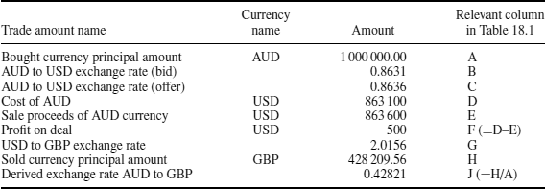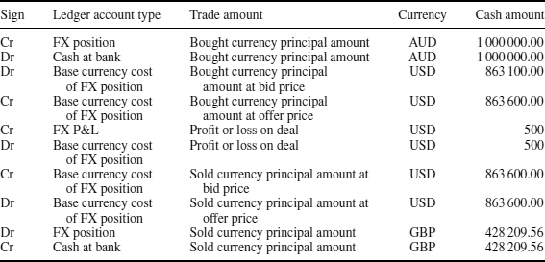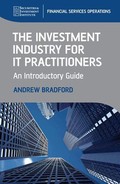Chapter 18
The STP Flow of Foreign Exchange and Money Market Trades
18.1 FOREIGN EXCHANGE
18.1.1 Order placement
Orders may be placed by any of the following means:
- By researching best bid and offer prices and telephoning a bank direct
- By researching best bid and offer prices and sending orders through hub and spoke services such as Omgeo Oasys or Autex
- By using any number of Reuters pre-trade services. Reuters is a major force in FX pre-trade services. Because the world’s major FX market makers publish their prices on its services it is able to act as an electronic money broker, finding competitive quotes. It also provides analytical tools and conversational dealing.
- By using the services of a money broker. The money broker will aim to provide “best execution” subject to and taking into account the nature of the order, the prices available to the broker in the market and the nature of the market in question. The money broker will charge a fee for its services, which is usually invoiced at the end of the month in which the order was executed. Money brokers offer both telephone-based services and also electronic order entry and matching services. The major force in electronic money broking for foreign exchange is a company called Electronic Broking Services (EBS). EBS was created by a partnership of the world’s largest foreign exchange (FX) market making banks. Approximately USD 145 billion in spot foreign exchange transaction, 700 000 oz in gold and 7 million oz in silver is traded every day over the EBS Spot Dealing System. It was created in 1990 to challenge Reuters’ threatened monopoly in interbank spot foreign exchange and provide effective competition.
EBS was the first organisation to facilitate orderly black box or algorithmic trading in spot FX, through an application programming interface (API). EBS was acquired by ICAP, the world’s largest money broker, in June 2006.
EBS claims to be the market leader for arranging deals in the EUR/USD, USD/JPY, EUR/JPY, USD/CHF and EUR/CHF currency pairs and Reuters is the leader for all other interbank currency pairs. In practice, banks that make markets in a wide variety of currency pairs need connectivity to both applications.
18.1.2 Order execution
Orders will be executed by the sell-side firm as principal; spot deals settle on T + 2 and forward deals settle on a date agreed by the trade parties. Section 4.2.1 explained how forward prices are calculated.
18.1.3 Trade amounts
Example
On 4 February 2008 for spot value date 6 February 2008, ABC Investment Bank plc purchases AUD 1 million (Australian dollars) from AN Other Investment Bank paying in GBP at an exchange rate of AUD 0.428458 to GBP 1.
This is an example of a cross-currency deal. In the London FX markets, banks normally buy and sell each currency against their FX base currency, which is usually the US dollar. Table 18.1 shows the rates (or prices) of the Australian dollar and the British pound versus the US dollar on 4 February, and the rate for this cross-currency trade is computed from the rates of the individual currencies against USD.
Table 18.1 Determining the cross-currency rate

The trade amounts (from ABC Investment Bank’s perspective) are as shown in Table 18.2.
Table 18.2 Foreign exchange trade amounts

The profit on the deal is the difference between the cost (measured in the base currency) of the bought currency and the sale proceeds of the bought currency.
18.1.4 Trade agreement
Trade agreement for FX trades is based on the “mutual exchange of confirmations” model that was examined in section 12.1.1. The relevant SWIFT message is the MT300. Where the deal has been arranged by a money broker, the money broker will also send a confirmation, and as a result it is necessary to agree both the confirmation received from the counterparty as well as the confirmation received from the money broker.
18.1.5 Settlement
The settlement agents of both trade parties will be held on each other’s SSI tables, which were described in section 10.6. ABC Investment Bank needs to send the following messages:
- An instruction (SWIFT MT202) to its GBP settlement agent requesting it to deliver GBP 428 209.56 to AN Other’s GBP settlement agent on 6 February.
- An instruction (SWIFT MT210) to its settlement agent for AUD requesting it to receive AUD 1 000 000.00 from AN Other’s AUD settlement agent on 6 February.
Settlement netting
Both bilateral settlement netting and multilateral settlement netting are possible for FX transactions.
Bilateral settlement netting is where two parties agree to settle only the net proceeds for FX deals each day. For example, if ABC and AN Other had struck the FX deals shown in Table 18.3 all for the same value date then the settlements would only involve the net totals for each currency.
Table 18.3 Bilateral settlement netting example

Multilateral settlement netting is made possible by the CLS Bank – refer to section 7.7.1. If these firms were CLS Bank participants then they each advise the CLS Bank of the trades that they have to settle, and it nets all the movements in each of the currencies down to a single net payment or receipt for that currency for each CLS participant.
The way that they advise CLS Bank about the trades to be netted is that they inform SWIFT of the fact they are CLS members. SWIFT then monitors all the FX trade confirmations that CLS members send to each other and passes the information on to the CLS Bank. Table 18.4 shows the net receipts and payments that ABC would make from and to the CLS Bank on 6 February if it and three other banks were CLS members.
Table 18.4 Net settlement with CLS bank

18.1.6 General ledger postings
All FX trade-related general ledger postings are passed on value date, it is assumed that settlement will take place in full on contractual value date. The accounting entries generated by the example trade will be as shown in Table 18.5.
Table 18.5 FX trade account postings on trade date

18.1.7 Stock record postings
The stock record is not used for trades where the instrument being traded is a currency.
18.1.8 Revaluing the position
As a result of this trade, ABC Investment Bank now has a long position in AUD and a short position in GBP. These positions need to be marked to market at the close of business each day using the closing exchange rates of this currency to the FX base currency, the US dollar. Marking to market is examined in section 23.8.
18.2 MONEY MARKET
18.2.1 Order placement
Orders may be placed by any of the following means:
- By researching best bid and offer prices and telephoning a bank direct
- By researching best bid and offer prices and sending orders through hub and spoke services such as Omgeo Oasys or Autex
- By using the services of a money broker. The money broker will aim to provide “best execution” subject to and taking into account the nature of the order, the prices available to the broker in the market and the nature of the market in question. The money broker will charge a fee for its services, which is usually invoiced at the end of the month in which the order was executed. Money brokers offer both telephone-based services and also electronic order entry and matching services.
- By using any number of Reuters pre-trade services. Reuters is a major force in money market pre-trade services. Because the world’s major banks publish their rates on its services it is able to act as an electronic money broker, finding competitive quotes. It also provides analytical tools and conversational dealing.
18.2.2 Order execution
Orders will be executed by the sell-side firm as principal. Executed trades are of two types:
- Fixed rate deals pay a fixed rate of interest and have a fixed maturity date. This is typically a period of one day, two days, one week or one month. However, two days before the agreed maturity date the two parties can agree to “roll it over”. If a deal is rolled over, then:
– The borrower will pay the interest due to the lender date on maturity date
– A new maturity date is agreed
– The interest rate is renegotiated for the next period.
- Call or notice deposits pay a variable rate of interest, and have no pre-agreed maturity date. The two parties may terminate the transaction by mutual agreement given two days’ notice.
Opening leg transactions for both deal types usually settle on T + 2 but can settle on any forward date agreed by the trade parties.
18.2.3 Trade amounts
Example
On trade date 5 March 2007, value date 7 March 2007, ABC Investment Bank borrowed GBP 1 000 000 from AN Other for 30 days at 5% interest, calculated on the actual/actual basis. The maturity date is therefore 6 April 2007.
On 6 April, ABC will repay the principal amount of GBP 1 000 000 + 30 days’ interest: Repayment amount = 1 000 000 + (1 000 000 * 30/365 * 5%) = GBP 1 004 109.59
The trade amounts in this example are as shown in Table 18.6.
Table 18.6 Money market trade amounts
| Trade amount name | Trade amount |
| Opening leg principal amount | GBP 1 000 000.00 |
| Closing leg consideration | GBP 1 000 000.00 |
| Interest rate | 5% |
| Interest to maturity | GBP 4 109.59 |
| Closing leg consideration | GBP 1 004 109.59 |
18.2.4 Trade agreement
Trade agreement for money market trades is based on the “mutual exchange of confirmations” model that was examined in section 12.1.1. The relevant SWIFT messages are the MT320 (used for fixed deals) and the MT330 (used for call and notice deals). Where the deal has been arranged by a money broker, the money broker will also send a confirmation, and as a result it is necessary to agree both the confirmation received from the counterparty as well as the confirmation received from the money broker.
18.2.5 Regulatory trade reporting
Regulatory trade reporting is not required for money market transactions.
18.2.6 Settlement
For the start leg, the borrower sends a SWIFT MT210 message to its settlement agent telling it to receive GBP 1 000 000.00 from the lender’s settlement agent on 7 March and the lender sends an MT202 message to its settlement agent to make payment of GBP 1 000 000.00 to the borrower’s settlement agent. The identities of the settlement agents will be held on the SSI tables described in section 10.6.
For the end leg, the borrower sends a SWIFT MT202 message to its settlement agent telling it to pay GBP 1 004 109.59 to the lender’s settlement agent on 6 April and the lender sends an MT202 message to its settlement agent to receive GBP 1 004 109.59 from the borrower’s settlement agent.
If the two parties agree to roll the deal over, then the borrower sends a SWIFT MT202 message to its settlement agent telling it to pay GBP 4109.59 to the lender’s settlement agent on 6 April and the lender sends an MT202 message to its settlement agent to receive GBP 4109.59 from the borrower’s settlement agent.
Business applications that build these messages need the ability to generate the start leg messages immediately, but hold the end leg messages until two business days before the maturity date. The concepts of bilateral or multilateral settlement netting do not apply to these transactions.
18.2.7 General ledger postings
These are the postings from the borrower’s point of view. The start leg transactions are normally posted on trade date, and the end leg transactions are normally posted two business days before maturity date (see Tables 18.7 and 18.8).
Table 18.7 Money market deposit account postings – start leg

Table 18.8 Money market deposit account postings – end leg

If the transaction is looked at from the lender’s point of view, then the entries become as shown in Tables 18.9 and 18.10.
Table 18.9 Money market loan account postings – start leg

Table 18.10 Money market loan account postings – end leg

18.2.8 Stock record postings
The stock record is not normally used in conjunction with trades in currencies.
18.2.9 Accrual of interest
During the life of the deposit or loan, interest needs to be accrued on a daily basis. Accrual of interest is explained in section 23.9.
